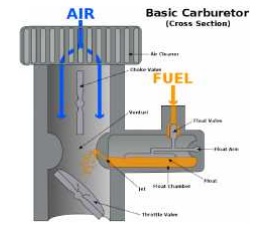Chapter: Mechanical and Electrical : Thermal Engineering : Internal Combustion Engines
Fuel Systems
FUEL
SYSTEMS
CARBURETOR
: (T.E R.K.R 598)
FUNCTION:
• A carburetor
is a device
that blends air and fuel for an internal combustion engine.
PRINCIPLE:
• The
carburetor worrks on Bernoulli's principle: the faster air mo ves, the lower
its static pressure, and the higher its dynamic pressure.
• The
throttle (accelerator) linkage does not directly control the flow of liquid
fuel. Instead, it actuates carburetor mechanisms which meter the flow of air
being pulled into the engine.
• The
speed of this fl ow, and therefore its pressure, determines the a mount of fuel
drawn into the airstream.
• When
carburetors are used in aircraft with piston engines, speci al designs and
features are needed to prevent fuel starvation during inverted flight. Later en
gines used an early form of fuel injection kn own as a pressure carburetor.

FUEL INJECTION: (A.E K.S
294-295)
Ø Fuel
injection is a system for admitting fuel into an internal combustio n engine.
Ø It has
become the prim ary fuel delivery system used in automotive en gines.
Ø The
primary differe nce between carburetors and fuel injection is that fuel injection atomizes the fuel by forcibly pumping it through a
small nozz le under high pressure, while a carburetor relies on suction created
by intake air accele rated through aVenturi tube to draw the fuel into the
airstream.
Ø Fuel is
transported from the fuel tank (via fuel lines) and pressuri sed using fuel pump(s). Maintaining the corr ect fuel pressure is done by a
fuel pressure regulator.
Ø Often a fuel rail is u sed to divide the fuel supply into the
requir ed number of cylinders.
The fuel injector injects liquid fuel into the intake air.
FUEL INJECTOR
Ø When
signalled by the engine control unit the fuel injector opens and sprays the
pressurised fuel into the engine.
Ø The
duration that the injector is open (called the pulse width) is proportional to
the amount of fuel delivered.
Ø Depending
on the system design, the timing of when injector opens is either relative each
individual cylinder (for a sequential fuel injection system), or injectors for
multiple cylinders may be signalled to open at the same time (in a batch fire
system).
Direct
injection
Ø In a
direct injection engine, fuel is injected into the combustion chamber as
opposed to injection before the intake valve (petrol engine) or a separate
pre-combustion chamber (diesel engine).
Ø Direct
fuel injection costs more than indirect injection systems: the injectors are
exposed to more heat and pressure, so more costly materials and
higher-precision electronic management systems are required.
Multiport
fuel injection
Ø Multiport
fuel injection injects fuel into the intake ports just upstream of each
cylinder's intake valve, rather than at a central point within an intake
manifold.
Ø The intake is only slightly wet, and typical fuel pressure runs between 40-60 psi.
Related Topics